There's an American Revolution of sorts going on at the Brooklyn Museum, with its American art collection being shuffled, re-hung and most importantly, re-interpreted with a critical eye on how we've looked at American art before.
The changes include new and more extensive labeling, giving serious thought to not only the history of the paintings and sculptures but to the circumstances of their time and of their makers.


This is an interim report; the process is well underway, but a large part of the exhibit area is closed for the next few months while the area transforms into a huge new Art of the Americas exhibit. Look for a new report late this fall!
 The two images at the top are a good place to begin. They are based on a series of images made by Charles M. Bell during an 1880 'peace conference' in Washington, DC, between leaders of the Crow tribe and officials who wanted the right to run rail lines across Crow land.
The two images at the top are a good place to begin. They are based on a series of images made by Charles M. Bell during an 1880 'peace conference' in Washington, DC, between leaders of the Crow tribe and officials who wanted the right to run rail lines across Crow land.
The images became popular as stereotyped, somewhat romanticized views of Native Americans, much as images of 'Oriental scenes' became popular in 19th-century Europe.
Wendy Red Star, a Crow herself, has given them new context by annotating them with details of the meaning of each of the details in the posed pictures. The notes (visible if you click on the images in the slideshow at end) not only give context to the images, they ask us to reconsider what we see when we look at American art.


This painting of a western landscape, showing Mount Hood, Oregon has hung in the Brooklyn Museum for years, along with other examples of American landscapes. It's by William Keith, who was hired in 1868 by a railroad and steamship company to paint scenes of the Pacific Northwest to lure customers. The new and more extensive museum labeling points out that Keith went beyond the landscape by inserting a view of Native people at a seasonal hunting camp, portraying a way of life his employers were bringing to an end.

The surprisingly detailed depiction of the camp would make an excellent painting on its own. Below, The Outlier, a 1909 work by Frederick Remington, a leading U.S. painter and sculptor of western scenes, most of them filled with action and spectacle. Whatever Remington's intent, this lone and unmoving figure movingly suggests the end of a way of life for Native peoples.
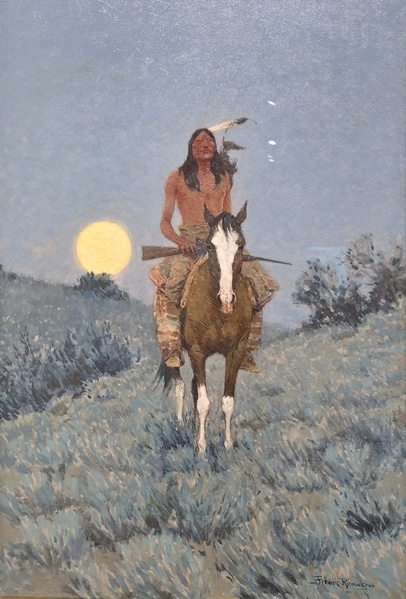
There are many other examples of class and race history to be seen in the pictures and narration—sometimes hidden, and sometimes pushed to the fore. The 18th-century scene by Agostino Brunias, above, is titled Free Women of Color with their Children and Servants.
The painting was commissioned by the British government to illustrate the complex social and racial hierarchies in its newly-acquired Dominica colony; the contrast of the Europeanized, and lighter-skinned, free women and the darker servants, the narrative tells us, "seemingly endorses the cultural and racial hybridity of the region; it also projects a colonial fantasy that erases enslaved labor." In short, with its new labeling, the painting now answers a question that we might otherwise have never asked. On the other hand, we have paintings like this Charles Willson Peale portrait of George Washington; in the new nation, portraits of iconic heroes helped to pull together the differing colonies. This one, by the way, was commissioned by John Hancock. One of the features of the new labeling is a much more detailed rendering of provenance: who owned the work when, and how it came to the museum.
On the other hand, we have paintings like this Charles Willson Peale portrait of George Washington; in the new nation, portraits of iconic heroes helped to pull together the differing colonies. This one, by the way, was commissioned by John Hancock. One of the features of the new labeling is a much more detailed rendering of provenance: who owned the work when, and how it came to the museum.

 The question of provenance is a big one these days for museums around the world as peoples and countries colonized or explored by Europeans and Americans in the 19th and 20th century have asked to reclaim cultural and artistic trophies that ended up in museums under sometimes questionable circumstances.
The question of provenance is a big one these days for museums around the world as peoples and countries colonized or explored by Europeans and Americans in the 19th and 20th century have asked to reclaim cultural and artistic trophies that ended up in museums under sometimes questionable circumstances.
For the Brooklyn Museum's American collection, this has meant a now nearly thirty-year-old process of discussion and negotiation with Native American tribes over items in the collection, not only over what is to be returned, but over appropriate ways to display and explain works that will remain.
Above, another idealized painting, this time of a Dakota woman, made by Harry Edwards, and likely based on photographs similar to Bell's.

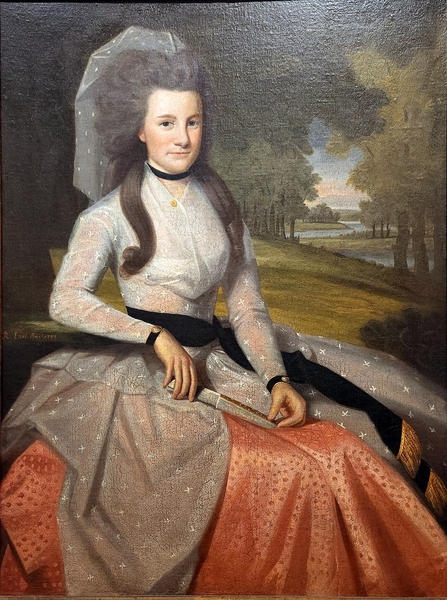

Formal portraits were not only to establish national heroes; they also served to announce their sitter's wealth, social status and more. The top pair are marriage portraits commissioned by family from John Singleton Copley; the next pair are by the less-well-known Samuel Lovett Waldo. The 'his' portrait shows a man of affairs with documents in hand, while 'hers' features only a luxurious setting. By the way, the husband, David Leavitt, was the founder of what became Dutch Boy Paint.
A more tender portrait, though no less formal, shows a father and his two young sons. The painter, Joshua Johnson, was born into slavery in 1763, and was freed in 1784. He is believed to be the first African-American artist to make a living by his art. Despite that success, it was only in 1939 that he was identified as the painter of his thirteen portraits of elite 19th-century Baltimoreans, and details of his life were not complete until the 1990s.
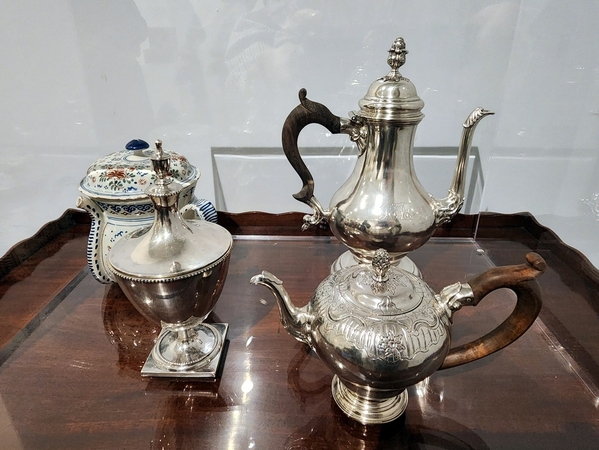 The exhibits include artistic work of craftspeople as well, with a new appreciation of not only who was in the market for such work, but of the makers, often enslaved or indentured workers whose names are lost because the name on the product is that of the master.
The exhibits include artistic work of craftspeople as well, with a new appreciation of not only who was in the market for such work, but of the makers, often enslaved or indentured workers whose names are lost because the name on the product is that of the master.

Francis William Edmonds's All Talk and No Work is unusual for its period because it neither caricatures nor idealizes the Black man as was common in scenes like this, which were popular in the 1840s and 1850s. Nevertheless, it is clear who is the farmer and who is the laborer.
If Edmonds's painting is ambiguous on issues of race and colonialism, The Peaceable Kingdom by Edward Hicks is a full-on attempt at disguise. Painted in 1833, and then again and again in more than sixty versions, it shows all God's creatures at peace with each other, and William Penn peacefully coming to agreement with the Lenape nation. What it does not show is the dirty dealings by which Penn's sons quickly dispossessed the Lenape of their land, a more usual ending to the story.
The land itself is a feature of many paintings in the collection, including the huge (10 feet x 15 feet, weighing 335 pounds) 1866 painting Storm in the Rocky Mountains, Mount Rosalie by Albert Bierstadt. Long a favorite of many Brooklyn visitors, it occupies a space that gives it the dramatic effect Bierstadt intended: He made his living not only by painting, but by organizing traveling shows of his paintings.
Those shows, displaying the dramatic West to audiences who were often motivated by such displays to move west themselves, or to support the 'Manifest Destiny' of white America to own the continent. Artistically, the Native peoples were erased from the scene even as they were being erased militarily.

Bierstadt's work was on a grand scale, meant for public display. But other landscape artists produced smaller works for 'home consumption,' and at least one, Grafton Tyler Brown, made an industry of it that could stand as a model for some of today's. One of the first African-American artists to work in the Pacific Northwest, he created a series of 28 images of Yellowstone (left, above). Tourist could select their preferred view or combination of views, and Brown would then produce a painted-to-order finished scene like the one below.

An ironic comment on landscapes and their meaning comes in this 2007 work by Valerie Hegarty, with the title Fallen Bierstadt. In it, she visually replicates the destructive effect on land and people of 'Manifest Destiny' and settlement of the west encouraged by the work of Bierstadt and others. Clearly, Bierstadt and his work were not the prime movers in that, but...

A little further along in the temporary display, the Museum returns to issues of class and gender, now in the mid-to-late 19th century, including three portraits, each with a story to tell.
Two careers intersect in this portrait, that of a young actress, Sarah Cowell, at the beginning of her career and clearly no shrinking violet and that of Jane Bartlett, the artist. Bartlett was a student of William Morris Hunt, known for teaching and mentoring women artists when many others wouldn't.
The Morning News, (1887) by Frederick James Boston is quite a change from the portrait of Mrs. David Leavitt we saw earlier. Rather than an idealized background, the woman—is she a maid or a working-class mother?—is shown surrounded by circumstances of daily life, but not limited to them. Like David Leavitt in the earlier portrait, she has papers and a connection to a wider world, illustrating a change in women's lives and aspirations.
 The painting above, Union Square, by Julian Weir, was part of a larger scene of urban street types and bohemian artists in New York's Union Square, including a woman in an independent role not shown tied to either home or work.
The painting above, Union Square, by Julian Weir, was part of a larger scene of urban street types and bohemian artists in New York's Union Square, including a woman in an independent role not shown tied to either home or work.
The larger painting was a critical failure, and Weir cut out an oval section and attached new canvas to fill the frame and painting details out into the new section. In a big ooops, he matched the paint color in the corners to the now-discolored varnish on the original. Years later, conservation and cleaning removed the varnish, leaving the difference between the oval and the rest quite clear.

From a later period, a portrait, Woman with Bouquet, shows some of the same independent spirit that can be read in the portrait of Sarah Cowell. It's by Laura Wheeler Waring, an important artist of the Harlem Renaissance, known also for her portraits of fellow artists, writers and leaders. Numbers of them are in the Smithsonian's National Portrait Gallery in Washington.
Moving into the 20th century—I still think of it as 'our century'—the museum has examples of a different sort of landscape, urban and industrial. The scene above, made by George Bellows in 1910, places a long line of workers entering a worksite in the background of a park scene along the Hudson River in New York. Other Bellows paintings of the period include one not on display at the moment of the excavation for construction of Pennsylvania Station; I hope it will be back in October!
In Maurice Kish's Job Hunters from 1933, the industry is front-and-center, as are the effects on the landscape and its inhabitants, the urban working class. Like many other artists of the period, Kish was an active left-wing political organizer and campaigner.
The museum has hung Kish's painting near another that appears quite different, but portrays some of the same themes. Bronx, N.Y. was painted in 1924 by Bumpei Usui, a furniture factory worker who had arrived in New York three years before, and shortly before a ban on Japanese immigration to the U.S.
Street Scene (Hester Street) by George Benjamin Luks captures the crowds, colors and connections of immigrant New York, in a painting typical of New York's 'Ashcan School.' Its label includes a quotation from Anzia Yezierska's 1925 novel Bread Givers.
It began singing in my heart, the music of the whole Hester Street. The pushcart peddlers yelling their goods, the noisy playing of children in the gutter, the women pushing and shoving each other with their market baskets—all that was only hollering noise before melted over me like a new beautiful song.
Perhaps that blending together of many things, visual, auditory, hidden and full of meaning, familiar and new is a good metaphor for trying to see American art in new and fuller ways, with all voices heard. I hope so.





















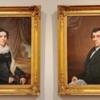


















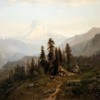








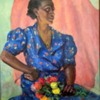
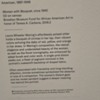











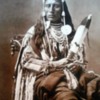

Comments (1)